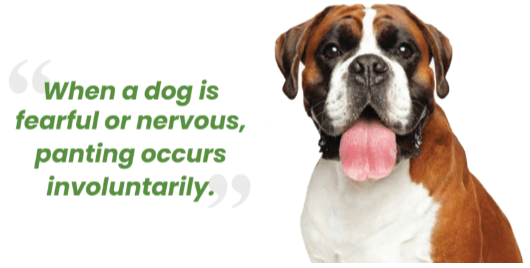Is Your Dog Panting Excessively?

All dogs pant, especially when it’s hot out, but excessive panting could be a danger sign. Here’s what you need to know.
Summer’s here, and your dog is frolicking in the grass. His tongue is lolling and he’s panting up a storm. Most of the time, a panting dog is little cause for concern. After all, every canine pants and there are numerous reasons why, most of which are perfectly normal. Excessive panting, however, can sometimes signal a problem that requires veterinary assistance. As a dog parent, it’s important for you to be aware of the differences and to know when to call your vet.
6 Reasons Why Dogs Pant
1. Warm Weather
One of the most common reasons for a dog to pant is because he is hot. “The evaporation of sweat from our skin cools us humans,” says veterinarian Dr. Doug Knueven. “Since dogs do not have sweat glands in their skin, the evaporation of oral fluids allowed by panting helps cool them down.” Certain dog breeds reach panting levels of heat far more quickly than others. “Breeds developed in different climates have different temperature preferences,” says Dr. Knueven. Some dogs also have a high rate of metabolism that can increase their temperature and lead to panting.
What to do: It is important to know your dog’s temperature tolerance both as an individual and as a member of his breed (or mix of breeds). Avoid exercising him when the weather is very hot and humid. Take him for walks in the mornings or evenings when the temperatures are a little cooler, and make sure he has 24/7 access to fresh, pure water. In the house, use AC or fans to help keep your dog comfortably cool.
2. Heat stroke
This is a life-threatening condition that all dog parents need to be aware of. It occurs when a dog is overheated, most often during the summer months. Excessive panting, heavy drooling, weakness, gait changes and collapse are all signs of heat stroke. “For flat-faced dogs, overheating can be especially dangerous, leading to respiratory distress,” says Dr. Knueven.
What to do: Pay close attention to your dog during hot weather and move him to a cool area immediately if he’s panting excessively or showing other signs that he’s getting too warm. If he’s exhibiting serious symptoms, get him to an emergency vet right away. “It is not wise to rapidly cool a dog suffering from serious heat stroke because it can throw his system into life-threatening shock,” Dr. Knueven cautions.
3. Anxiety
When a dog is in a stressful situation, he can become anxious. And when he’s fearful or nervous, panting occurs involuntarily. Being in an unfamiliar place, away from his people, at the vet’s office, in a vehicle, crate or other restricted location can lead to anxiety and excessive panting. And when a dog is fearful or nervous, panting occurs involuntarily. Often, the level of stress is directly proportional to how much the dog is panting.
What to do: Paying close attention to your dog and noticing how much he pants in certain situations can help you recognize when you need to take steps to ease his stress or even avoid situations that may be triggering him.
4. Pain
It’s often not obvious when dogs are in pain, since they’re good at hiding discomfort. But one possible sign is excessive panting. Panting without a clear cause may indicate that your dog is ill or injured, or suffering from a health condition that generates pain or discomfort, such as arthritis or GI distress.
What to do: If you suspect your dog is in any pain or discomfort, whether he’s panting or not, a trip to the vet is in order. He’ll need an examination and possibly some diagnostic tests to get to the root of the problem.
5. Medication
Various medications may lead to excessive panting if they make a dog feel uncomfortable. Some drugs cause a variety of side effects such as nausea, blood pressure changes, and more. Panting can be a normal side effect of the medication, or it can be a red flag. “Steroids such as prednisone are especially notorious for causing panting,” says Dr. Knueven.
What to do: If your dog has to go on a conventional medication, it is always wise to discuss any potential side effects with your veterinarian to determine what might be expected. If your dog becomes particularly uncomfortable while on the medication, ask your vet if the dosage or type of drug needs to be adjusted.
6. Cushing’s disease and other conditions
Cushing’s is an often chronic illness whose symptoms include increased panting that can occur all hours of the day, regardless of weather conditions. “Cushing’s disease is also commonly accompanied by excessive thirst and urination as well as a swollen abdomen,” adds Dr. Knueven. Disease-related panting can also be caused by high blood pressure conditions, infections causing fever, bloat, heart disease, lung diseases such as asthma, bronchitis, pleural effusion, and cancer.
What to do: New patterns of panting, especially at seemingly odd times, merit a visit to the veterinarian. When it comes to disease-related panting, there are many potential causes, so tests will need to be done to determine the cause. Blood testing, x-rays, and more can be vital diagnostic tools.
Excessive panting can have many causes, some of which are life-threatening or signal serious illness. Any change in your dog’s behavior, including how much or how often he pants, needs to be checked out. And remember to keep him cool during the dog days of summer!




